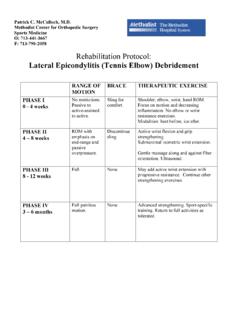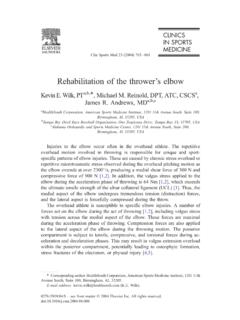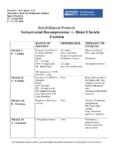Transcription of Management of Scapho-lunate ... - Anderson Hand …
1 Management of Scapho-lunate Injuries: A review of current thinking The ligament complexes between and amongst the two rows of carpal bones in the wrist permit such significant and precise motion that some say they have contributed to man s rise to prominence as the most powerful animal on this planet (Couzens, 2009). However the downside to this complex arrangement is its inherent instability. Scapho-lunate joint injuries are the most frequent cause of carpal instability. Damage to this joint may seem innocuous, however if not treated with respect, can lead to an alteration in carpal mechanics which over time may create degenerative change and severe wrist dysfunction. Conservative Management of Scapho-lunate injuries has traditionally relied heavily on extended periods of splinting, followed by extended periods of graduated motion and strengthening. Certainly until recently, there was very little precise biomechanical science engaged in the rehabilitation of these complex injuries.
2 However over the past decade there has been an increasing amount of noise at the highest levels of hand and wrist surgery espousing the potential of a movement pattern referred to as the dart throwers movement (DTM) (Moritomo, 2007). Integration of this pattern into rehabilitation programs has the potential to permit early mobilisation either before or after or instead of repair of this ligament (Kuo, 2008). Combining knowledge of how wrist anatomy and biomechanics contribute to the DTM pattern, and integrating the developing understanding of wrist proprioception, is changing the Management of Scapho-lunate injury. Scapho-lunate Ligament Injury: The Scapho-lunate ligament is most often injured with either a fall, or with repeated loading to failure. The wrist is typically in extension and ulnar deviation, and the capitate is forcefully driven between scaphoid and lunate disrupting the ligament. If there are no signs of instability on x-ray and examination, then a period of conservative treatment is considered appropriate.
3 Changes in static films, like the Terry Thomas sign of a widened gap between the scaphoid and lunate, are usually only seen if a secondary stabiliser is also disrupted, and are indicative of a dynamic instability (Kuo, 2008). If the injury is severe enough to cause dynamic instability it will require surgery. This could range from direct arthroscopic repair with or without pinning of the interval, to a salvage procedure such as a proximal row carpectomy. The latter is generally used only in instances of severe joint degeneration. Anatomy: The scaphoid, lunate, and triquetral bones are an intercalated segment. This means that no tendons insert here, making their movement dependant on forces imposed upon them by the surrounding ligamentous structures. The Scapho-lunate interosseous ligament (SLIL) itself, is a seamless transition between the articular surfaces of the scaphoid and lunate (Kuo,2008). It is a C shaped ligament with 3 sub regions, dorsal, palmar and proximal.
4 Of these, the dorsal is the thickest and most important, with the proximal portion providing little restriction to abnormal movement. Secondary stabilisers are both intrinsic and extrinsic ligamentous complexes, with the importance of the sensory laden dorsal radiotriquetral (DRC), and dorsal intercarpal (DIC) ligaments becoming more apparent. These secondary stabilisers are not substantial enough create instability if injured on their own, but are important to overall carpal kinematics. The combination of a strong intrinsic ligament and the surrounding extrinsic ligaments mean that the intercalated segment described above must operate as a unit depending on the direction the hand takes. However, the precision that hand function demands of the wrist joint means that there must also be motion of the bones within the segment relative to each other. This inter-carpal movement is most apparent at the end ranges of flexion, extension, ulnar and radial deviation.
5 The implications of this are that if there is damage to the SLIL, then movement must be restricted in order to encourage healing. The Dart Thrower s Movement: When the hand is used for most activities, it rarely relies on wrist movement in a strict singular plane. Rather it uses a combination of movement patterns to position the hand in space. This mixed movement of radial-extension to ulnar-flexion is most commonly seen in activities like bouncing or throwing a ball, pouring water from a jug, or drinking from a cup. In fact, it is difficult to think of tasks that are not multi-planar that do not integrate this pattern in some way. The physiologic importance of this motion is that relative to each other and to the radius, the scaphoid and the lunate move very little during the mid-range of this pattern. Certainly their movement is remarkably reduced during the DTM as compared to the single planes of flexion, extension or ulnar and radial deviation (Moritomo, 2007).
6 It is this relative lack of motion that has encouraged the integration of this pattern into the early mobilisation of an injured SLIL. Stability and Function: The DTM pattern is a stable movement because it does not operate in isolation. Rather, its functionality is demonstrated as it creates the optimal cocking position of wrist and arm, which then move rapidly into extension through a power swing or throw. During this process there is also maintenance of hand / eye co-ordination with alignment of the wrist , elbow, and shoulder joint (Ross, Couzens, 2009). The DTM is not an isolated, distal movement, and should not be treated as such in rehabilitation. This, by the way, is a good general rule for most hand injuries, neglect proximal structures at your peril! Muscle & Ligament Input: There are three important muscles that are responsible for generating the DTM. These are extensor carpi radialis longus and brevis (ECRL/B), abductor pollicis brevis (AbPB), & flexor carpi ulnaris (FCU).
7 The relevant antagonist muscles are flexor carpi radialis (FCR), and extensor carpi ulnaris (ECU). Reflex stimulation of the SLIL has shown inhibition of ECU. ECU s impact upon the distal carpal row is to encourage its pronation and therefore widen the Scapho-lunate interval. Whilst the SLIL is intact, the FCR effectively resists this motion. However if the SLIL is disrupted, the FCR s movement arm will increase load through the radial carpus, increasing scaphoid displacement (Garcia-Elias, 2007). However, during the DTM, the emphasis is on the SLIL friendly muscles. ECU and FCR are effectively switched off, thus avoiding stress to the SLIL. The dorsal ligamentous structures are densely packed with mechanoreceptors, working to provide the required sensory feedback for precise wrist control. The more dense radial and palmar columns contain little to no sensory innervation and are instead responsible for the required mechanical restraint (Hagert, 2010).
8 Rehabilitation: It follows then, that if you are trying to rehabilitate a wrist following SLIL injury, that active movement should at first be constrained to the DTM, and preferably the mid-range of this pattern because the DTM has been shown to minimise stress to the SLIL. Muscles that are friendly to the ligament, ie those that encourage movement in the DTM plane should be isolated. Exercises should be designed to exaggerate the pattern, integrating the so-called DTM friendly muscles FCU and ECRL, which work to protect the joint (Garcia-Elias, 2010). Isolation of this movement provides sufficient proprioceptive input to wrist mechanoreceptors to enhance wrist control, and in the case of SLIL injury, encourage the secondary stabilisers to kick in. Incorporating forced proprioceptive input into the program will then further enhance the ability of the relevant mechanoreceptors to influence safe movement (Hagert, 2010). The DTM is a stable and functional pattern of movement.
9 At the very least, adoption of the DTM as part of a wrist rehabilitation program appears to have the potential to enhance current therapy protocols. Integrating accurate and normal carpal kinematics into wrist rehabilitation should lead to early and safe mobilisation and likely better outcomes. CASE STUDY: The patient was a 62 year old, retired, right-handed woman. She played competition tennis once a week, swam twice a week, and went to the gym twice a week. After a fall at the gym onto her right hand in February 2009, the wrist became painful and ached. She reported significant discomfort when weight bearing, and that it caught and clunked with certain movements. The patient sought medical treatment in March 2009. An x-ray showed no fracture. She was given a wrist splint to wear, had soft tissue work and completed a generic exercise program. This intervention provided no relief of her symptoms. In June 2009 the patient had an MRI, which showed a grade 3 disruption of the scaphoid-lunate ligament after another negative x-ray.
10 A Watson s test was negative, however she had a positive ballottement sign, and significant pain over the scaphoid-lunate interval. A cortisone injection was administered, however this also brought no relief. She saw a hand surgeon who felt that a scaphoid-lunate ligament repair was not appropriate because of her age, and the length of time since injury. She wanted to avoid a salvage procedure, and was offered further conservative Management . In late July 2009, a referral was made to a hand therapist for fabrication of a splint that restricted wrist motion to the dart throwers plane. After six weeks of wearing the splint at all times, removing it only for hygiene, there was minimal tenderness over the scaphoid-lunate interval. The patient reported that the catching sensation she had had, was now gone, and she reported better hand function. At week 6 an exercise and strengthening program based on the DTM was initiated. FCR and ECRL were targeted.








